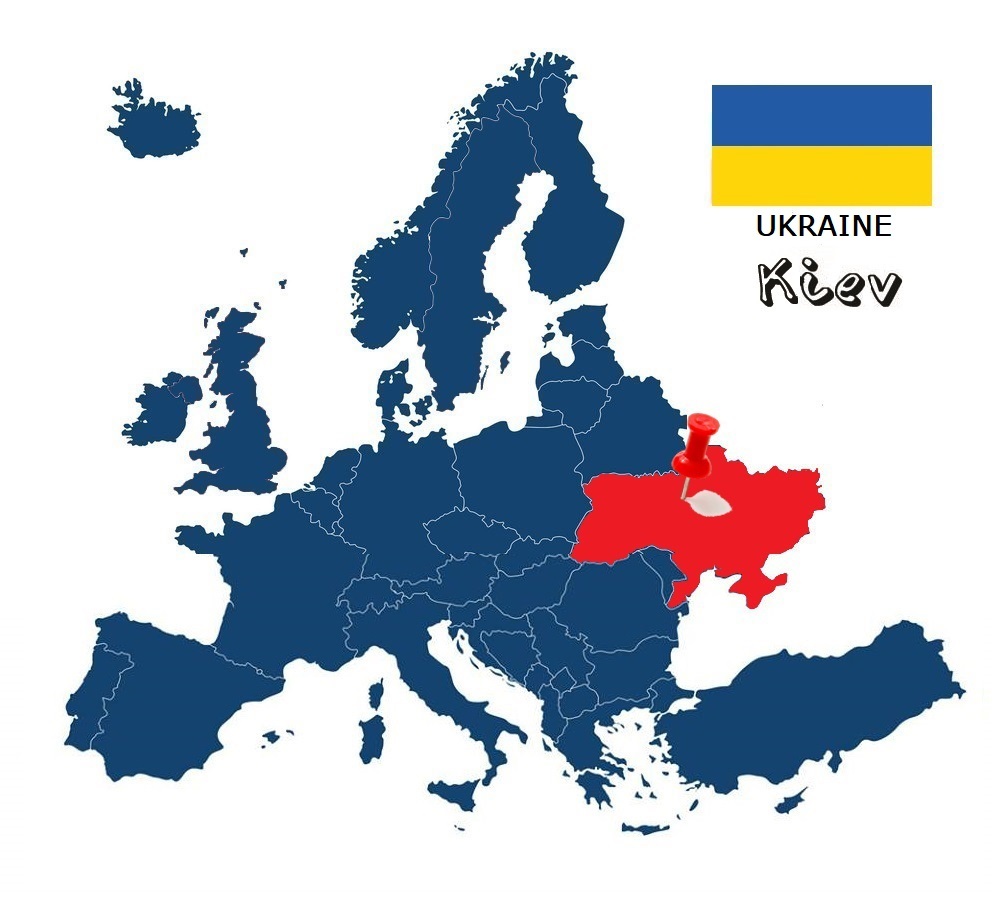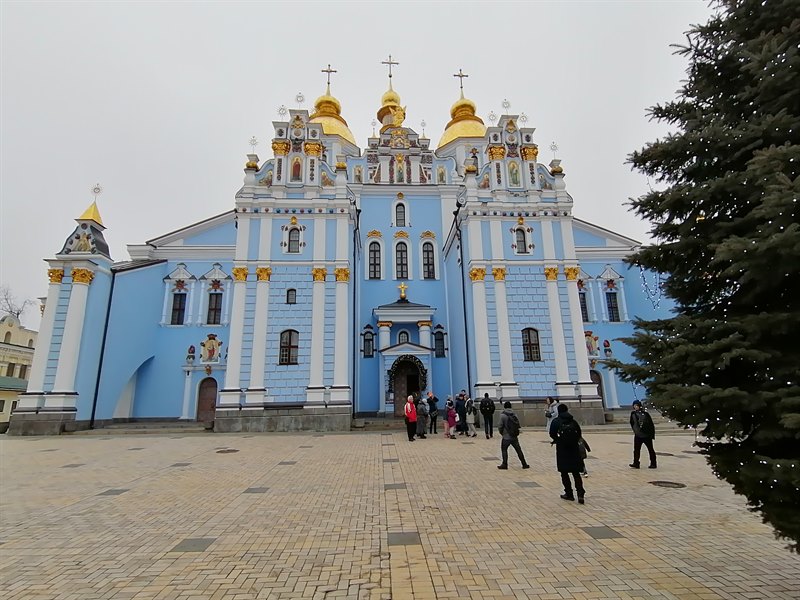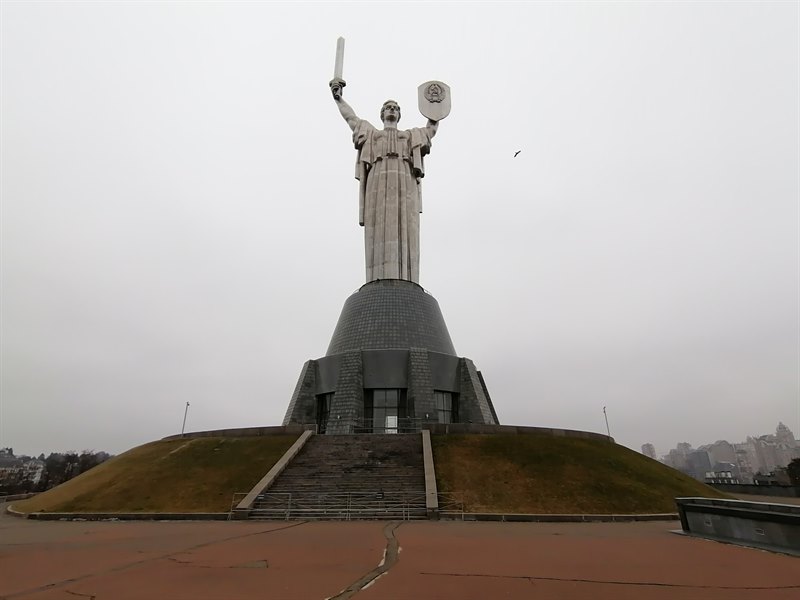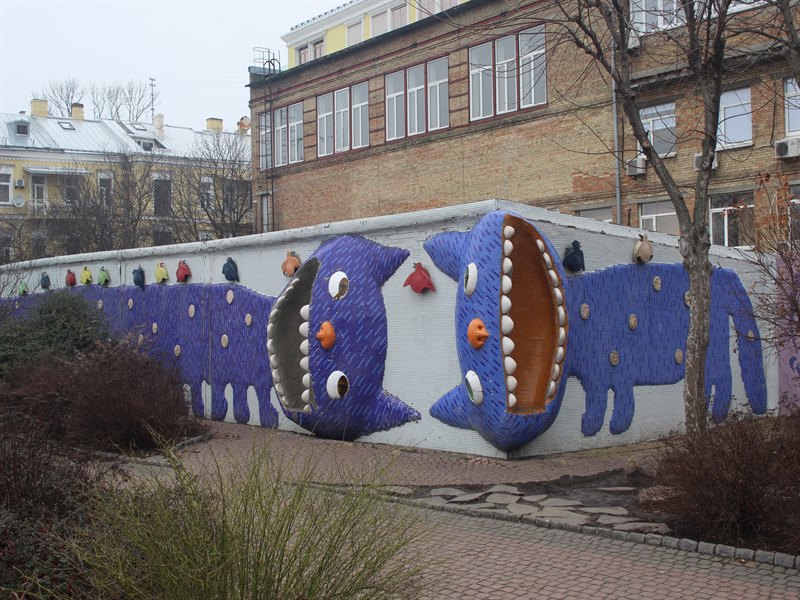
Impressive churches, glittering villas, lush parks, interesting museums, Soviet-style building complexes and Europe's third largest river are just a few of those to see in the Ukrainian capital. A “'different'” European destination, full of unique cultural treasures waiting to be discovered.
A few words about the city
Kiev is the capital and largest city of Ukraine, with a population of 2,907,684 inhabitants. It is built on the banks of the Dnieper River, which is floating and is one of the oldest cities in Europe. Its history dates back to the 5th century AD, when it was established as a trading station for eastern Slavic tribes living in the wider area, and was also a focal point for Byzantines. In 1240 Kiev was destroyed by the Mongols and has since been downgraded to a small regional town, until it flourished again in the late 19th century in the context of the Russian industrial revolution. It was then destroyed again by the Germans during World War II, but it was rebuilt immediately and became the third most important city (after Moscow and St. Petersburg) in the post-war USSR. The city is also known under the unofficial name New Jerusalem, because of the intense Christian element and the countless churches that exist there. So I will try to present Kiev through my eyes and share with you what I think one should see, visiting the city for the first time.
Sofiiski Sobor
The Cathedral of Saint Sophia (Sofiiski Sobor) is perhaps the most recognizable attraction of the city and took its name from the Saint Sophia of Istanbul. According to historian Dr. Nadia Nikitenko, the temple was founded in 1011, under the reign of Yaroslav's father, the Great Prince Vladimir the Great, while this information accepted by UNESCO, recognizing the Cathedral as a World Heritage Site in 1990. It is an outstanding architectural monument of Kievan Rus, with its impressive green and gold domes, and the large gold bell tower, measuring 16 meters high. Even inside the church you will admire mosaics and murals written in Greek! The admission to the courtyard costs 20 Hryvnia (about 75 cents), while to enter the interior of the church and the bell tower you will need 180 and 60 Hryvnia (7e and 2.5 e). Attention, the photos inside are prohibited.
Andriyivs'ka tserkva
A second church worth a visit is the St. Andrew's Cathedral (Andriyivs'ka tserkva). It is a baroque royal church, as evidenced by the lack of a bell tower, since in the royal churches there was no need for the people to call and therefore the need for bells. The church was built between 1747 and 1754 by Italian architect Bartolomeo Rastrellielli and is on the list of mankind's "Treasures of Five Continents from World Society." Due to the fact that it is located on top of a hill, the fundamental problem is one of the main concerns of the conservators. In fact, some cracks have recently appeared on the outer casing of the temple, and as a result it is under maintenance until further notice. However, due to its location, it has panoramic views of the historic Podil district, so it is worth giving 20 Hryvnia (about 75 cents) for a stroll around the enclosure.
Mikhailovsky Zolotovekhy Monastyr
A few meters from St. Andrew's Cathedral you will find my favorite city church, St. Michael's Monastery (Mikhailovsky Zolotovekhy Monastyr), the patron saint of Kiev. This monastery is located on the right bank of the Dnieper River and has become widely known for its golden domes. The original building comes from the middle Ages, while the monastery consists of the cathedral, the dining room of St. John of God, built in 1713, the economic gates, which were built in 1760 and the bell tower of the monastery, which was added in 1716-1719. The exterior of the structure was rebuilt in the Ukrainian Baroque in the 18th century, while the interior remained in its original Byzantine style. The original cathedral was demolished by the Soviet authorities in the 1930s, but rebuilt and opened in 1999 after Ukrainian independence. Entrance to the temple is free of charge.

Pechersʹka lavra
The next imperative stop is the Convent of the Caves Lavra (Pechersʹka lavra). It is an Orthodox Christian monastery which, although a tourist attraction for the city of Kiev operates normally. The monastery complex is built on a hill on the right bank of the Dnieper, and currently, the jurisdiction area is divided between the State Museum, the National Historical-Cultural Monument, and the Orthodox Church of Ukraine, in which it has its seat the head of the Monastery and also is the residence of its leader, the Bishop Onuphrius. Since its foundation in 1051, the monastery has become a prominent center of the Eastern Orthodox Church in Eastern Europe and together with the cathedral of St. Sophia of Kiev, has been declared a world heritage site by UNESCO in 1990. The entrance to the monastery costs 80 Hryvnia (i.e. approximately 3e) and with this ticket you will have access to all of the individual buildings and the bell tower with wonderful views of the river.
Zoloti Vorota
The Golden Gate (Zoloti Vorota) was the main gate of the fortifications of Kiev in the 11th century and took its name from the equivalent of Istanbul. Its structure was dismantled in the middle Ages, leaving few remnants of its existence and completely reconstructed by the Soviet authorities in 1982, although there were no images of the original designs. The decision was extremely controversial because there were many competing views on how the original Gate looked and how it should be rendered. On top of it, there is, of course, a church, which served the "heavenly" protection of the city. From there, if the atmosphere is clear, you will be able to admire the city of Kiev from above. Entrance to the gate costs 20 Hryvnia (i.e. about 75 cents). Since you are in the area, do not hesitate to enter the corresponding metro stop (Zoloti Vorota), which is located directly opposite and is considered one of the most beautiful in Europe.

Maydan Nezalezhnosti
Perhaps the most central point of Kiev is Independence Square (Maydan Nezalezhnosti). To understand its significance for the city, it is sufficient to consider that locals often call it simply square (maydan). This spot was also a regular venue for non-political gatherings and events, but since 2014 most of them have been moved to Sofiyivska Square, as entertainment at a place where people were killed during Euromaidan was deemed inappropriate. In the center dominates the monument of Independence, a column made with a mixture of Ukrainian baroque and aristocratic architecture, on the 10th anniversary of the independence of Ukraine in 2001. The statue at the top of the column is made of bronze cast iron and weighs about 20 tons! Finally, the square has other important sights such as the Kiev Founder's Monument, the Lach Gate, the Monument to Pietro Stolipi, the monument dedicated to the Great October (Lenin), the bust of Karl Marx, but also some noteworthy buildings suchthe Ukrayina Hotel, the Post Office, the Ukrainian Trade Union Building and the Tchaikovsky Music Academy.
Khreschatyk Street
In front of the above square passes the country's main street, Khreschatyk Avenue. It is a road that runs from the European Square (northeast) through Maidan and ends at Bessarabska Square (southwest), where Besarabsky Market is located. The whole street was completely destroyed during the Second World War by the troops of the Red Army and rebuilt in the neo-classical style of post-war Stalinist architecture. Among important buildings that did not survive were the Duma of Kiev, the Kiev Stock Exchange, the hotel Natsional and the House of Ginzburg. Today the Khreschatyk bustles with life, being full of hotels, shops, restaurants, cafés, as well as of government buildings.
Batʹkivshchyna-Maty
Undoubtedly the most impressive building in Kiev is the Motherland Monument (Batʹkivshchyna-Maty). This spectacular 65-meter steel statue is part of the National Museum of History of Ukraine during World War II, and you can admire it for free. The sword in the right hand of the statue is 16 meters and weighs 9 tons, while in his left hand holding a shield of 13 meters, with the state emblem of the Soviet Union. Of particular interest is the fact that the sword of the statue was cut, because its edge was higher than the sacred cross of the church of the Lavra! If you want to enter this very interesting museum, you will have to pay 30 Hryvnia (i.e. about 1 euro). Inside you will see various exhibitions, most notably the monumental hall featuring some marble slabs engraved with the names of more than 11,600 soldiers and more than 200 workers honored during the war under the title of Soviet Hero and Hero of Socialist Work, respectively.

Arka druzhby narodiv
On a hill above the Dnieper River, you will find the Friendship of Nations Arch (Arka druzhby narodiv). It was presented together with the Ukrainian House on November 7, 1982, to commemorate the 60th anniversary of the USSR and the celebration of the 1,500th anniversary of the city of Kiev. Despite the importance of the arch for Kiev, in 2016, the government announced plans for its dissolution and placement in its place, a monument dedicated to war veterans in Donbass. As you can see, these announcements have provoked reactions, and as a result they have been withdrawn. Today, due to the strained Ukrainian-Russian relations, a crack has been painted on the arch, which according to the artists will only be removed when the relations between the two countries are normalized (so probably never).
Peyzazhna Aleya (Park Landscape Alley)
This park is unique and unquestionably one of the most "instagram friendly" places in Kiev. It was created in 1980 by architect Abraham Miletsky and was originally intended as another point of view for the Dnieper River. But over the years, this alley was filled with modern masterpieces, being now an open-air museum. In this park you will find playgrounds, benches, fountains and sculptures, all made with colorful mosaic tiles, with most famous of them the Kiev cat. The summer months are full of both children and adults, who are rushing to watch the original exhibits, to walk in nature or have a picnic.

The museums
The first museum worth visiting in Kiev is the National Museum of Chernobyl (Natsionalnyy muzey "Chornobyl"). It is perhaps the most important museum in the city, dedicated to the major destruction of the Chernobyl nuclear power plant in 1986 and its consequences. It hosts an extensive collection of visual media, objects, scale models and other elements, designed to educate the visitor on the many aspects of the disaster. Several exhibits illustrate the technical progress of the accident, while there are also many areas dedicated to the loss of life and the cultural consequences of the disaster. Entrance to the museum costs 30 Hryvnia (i.e. about 1e), while if you want an audio guide, you will need to pay an additional 50 Hryvnia (about 1.8 e).
Another place of art worth a visit in the city is the National Museum of History of Ukraine (Natsionalʹnyy muzey istoriyi Ukrayiny). This museum depicts the history of Ukraine from ancient times until today, housed in a charming 1939 building, designed by the Greek architect Joseph Karakis. The exhibits presented include: ethnographic material, archaeological objects such as an important collection of Scythian art, historical paintings and sculptures, monetary collections, early printed books, etc. Entry costs 30 Hryvnia (ie approximately 1e).
Finally, it is worth a walk from the Pinchuk Art Centre (Art-tsentr Pinchuka). It is the largest private museum in Eastern Europe and has been donated by billionaire Victor Pinchuk since 2006. Present a collection of works by Ukrainian and international artists, aiming to take out the complexity of the era and the important issues that we face as a society. Admission is free.
How to go
Kiev has two airports: Boryspil International Airport (Аеропорт Бориспіль) and Zhulyani Airport (Аеропорт кив (Жуляни), which is smaller and is only 8 km from the city centre. The best way to get to the city coming from Wizzair (Zhulyani Airport), where one can get tickets from € 48 round trip! If you want a more comfortable flight, you can choose a flight with Turkish Airlines with a stopover to Istanbul from 179 € round trip.
Where to stay
The fact that Kiev is not a highly touristic city is also reflected in the prices of its accommodation. In the city there are plenty of hotels, hostel and rooms, for all tastes and all budgets. My suggestion is the Kyiv Cozy Loft, a beautiful room, a breath away from the city center and very close to a tram and metro station.
How to move
Kiev is a large city, with long distances, and its attractions are spread all over it. However, it has a very good transportation network of subway, bus, trolley, tram and cable car services, covering the whole city. The Kiev Metro, which by the way has the deepest metro station in the world (Arsenalna,105 metres deep), will become your best friend. There are three lines and the one-way ticket costs 8 Hryvnia, which is 20 cents of the euro! In fact, tickets are not common as they are in the form of a plastic coin. For other means of public transport, tickets can be purchased from the driver and must be validated on the special machine there. Finally, depending on the days you stay you can get unlimited travel cards, for all public transport.
What to eat
Ukrainian cuisine is quite 'heavy', which makes perfect sense when you consider the weather. It has several influences from Russian and Georgian cuisine and loves soups, meat, sour cream, bread and potato. Some of the most traditional dishes in the region are borshch soup (pink beets soup), varenyky (stuffed dumplings), holubtsi (cabbage leaves with tomato sauce), pelmeny (meat-filled ravioli) and of course the famous chicken Kiev (fried chicken with garlic). To taste authentic Ukrainian dishes like borshch and varenyky, i suggest you to visit the Kanapa Restaurant Salon, for chicken Kiev, of course, the Chicken Kyiv, while for coffee and breakfast, the Milk Bar, Khurma Georgian Café and 99 LARI.
Useful information

In Ukraine, we travel with a Passport valid for at least 6 months and do not need a visa in advance. When you enter the country, your passport will be stamped.
In Kiev, the language used is, of course, Ukrainian, while most speak Russian. Younger people know English, and everyone is willing to help if they know.
The currency of the country is the Hryvnia (UAH) and its exchange rate is currently 1 € = 26.71 Hryvnia.
Convert your money either to the dozens of banks in the city, or to the exchange offices, which indicate the exchange rates, since they get very little commission.
Getting to and from Kiev airports is easy, as there are trains and trolleys that will take you to the city center or airports.
The Greek Embassy in Kiev is located at 10 Dobrovolchykh Batalioniv Str. (former Panfilovtsiv) and its phone is +38 044 2545471.
Due to its location, Kiev has very cold winters; with the temperature usually many degrees below zero. So the best time to visit the city is in the spring and autumn, as well as during the Easter season when it is particularly chilly.
Recommended excursions → Chernobyl, Lviv, Odessa

If this article seemed interesting or contributed to your quality information, then you can like my facebook page: o_thessalonikios or follow me on instagram!
Mouzakidis Pantelis








